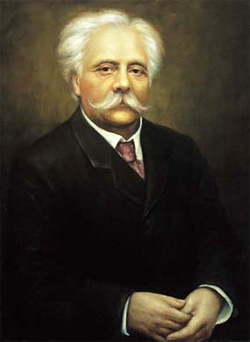Gabriel Fauré
| Born | |
|---|---|
| Born name | Gabriel Urbain Fauré |
| Date of Born | May 12, 1845 |
| Place of Born | Pamiers |
| Died | |
| Date of Died | November 4, 1924 |
| Place of Died | Paris |
| Cause of Died | Pneumonia |
| Burial | Passy Cemetery |
| Gender | Male |
| Nationality | French |
| Occupation | University lecturer, composer, organist, musicologist, music teacher, educator, pianist, court conductor |
| Family | |
| Father | Toussaint Fauré |
| Spouse | Marie Fauré |
| Lovers | Emma Bardac, Marguerite Hasselmans |
| Children | Emmanuel Fauré-Frémiet, Philippe Fauré-Frémiet |
| Teachers | Camille Saint-Saëns, Gustave Lefèvre |
| Students | Maurice Ravel, Charles Koechlin, George Enescu, Nadia Boulanger, Émile Vuillermoz, Louis Aubert, Gretchen Osgood Warren, Lucien Garban, Raoul Laparra, Émile Jacques-Dalcroze, Alfredo Casella, Emil Frey, Lili Boulanger |
| Artistic Career | |
| Active Years | 1861 – 1924 |
| Education | Niedermeyer School, Paris |
| Movements | Romantic music, Impressionist music |
| Genres | Opera, Romantic music, Classical music |
| Instruments | Pipe organ |
| Member of | Paris Academy of Arts |
| Notable Works | Requiem, Élégie, Piano Quintet No. 2 |
| Awards | Legion of Honour (1st Class, 5th Class, 4th Class, 3rd Class, 2nd Class) |
Gabriel Urbain Fauré (French: [ɡabʁiɛl yʁbɛ̃ fɔʁe], born in 1845 in Pamiers, died in 1924 in Paris) was a French composer and organist. He is considered one of the most outstanding composers of 19th-century France, and his compositional style had a significant influence on 20th-century composers. Many of his famous works were composed in his early life, such as *Pavane*, *Requiem*, *Sicilienne*, his nocturnes for piano, and songs like *Après un rêve* and *Clair de lune*. Although his later works are less well-known, they are highly regarded for their complexity in harmonic and melodic style. Fauré’s music is seen as a bridge between Romantic music and the modern music of the 20th century. In the last 20 years of his life, Fauré suffered from progressive hearing loss, which significantly influenced his later compositions. His music during this period is sometimes characterized by a more introspective, elusive quality, in contrast to the charm of his earlier works.
See More :
Gabriel Fauré was one of the towering figures in French music of the late 19th and early 20th centuries, and greatly influenced many later composers world-wide. He was born in Pamiers in the south of France, but was sent to Paris at the age of nine, to study at the Ècole Niedermayer in Paris, with teachers including Camille Saint-Saëns. He later became a regular at the salons of Saint-Saëns, and also eventually succeeded his former teacher as choir master at the Èglise de la Madeleine.
In 1870, he served in the army during the Franco-Prussian War. Following a broken engagement in 1877, he went travelling, spending some time in Germany where he met Liszt and Wagner.
He married in 1883, continued to hold various positions and to compose songs and piano music, slowly developing his very personal and harmonically complex musical style.
At the age of fifty-one, he finally became chief organist at the Èglise de la Madeleine, and months later he was appointed composition teacher at the Paris Conservatoire, where his pupils included Maurice Ravel, Nadia Boulanger and George Enescu. In 1905 he became director of the Conservatoire in the aftermath of the scandal of the refusal of the Prix de Rome to Ravel.
He retired from the Conservatoire in 1920, mainly due to his increasing deafness, but continued composing until his death at 79.
Major works:
Choral music: Requiem
Other Vocal music: songs (Après un Rêve, En prière, Sylvia etc) and song cycles (La Bonne Chanson, Le Jardin Clos etc)
Piano music: Barcarolles, Nocturnes, Impromptus
Chamber music: Two Violin Sonatas, two Cello Sonatas, String Quartet, Piano Trio, Piano Quartet, two Piano Quintets
Orchestral: Ballade (piano and orchestra), Fantasie (piano and orchestra), Elégie (cello and orchestra), Berceuse (violin and orchestra), Masques et Bergamasques, incidental music for Pelléas et Mélisande
All pieces: |
||||
|---|---|---|---|---|
Nocturnes |
||||
| Nocturne 1 Op. 33 No. 1 | E-flat Minor | – | 8 | |
| Nocturne 2 Op. 33 No. 2 | B Major | – | 8 | |
| Nocturne 3 Op. 33 No. 3 | A-flat Major | – | 7 | |
| Nocturne 4 Op. 36 | E-flat Major | – | 8 | |
| Nocturne 5 Op. 37 | B-flat Major | – | 8+ | |
| Nocturne 6 Op. 63 | D-flat Major | – | 8 | |
| Nocturne 7 Op. 74 | C-sharp Minor | – | 8 | |
| Nocturne 8 Op. 84 No. 8 | D-flat Major | – | 7 | |
| Nocturne 9 Op. 97 | B Minor | – | 7 | |
| Nocturne 10 Op. 99 | E Minor | – | 8 | |
| Nocturne 11 Op. 104 No. 1 | F-sharp Minor | – | 7 | |
| Nocturne 12 Op. 107 | E Minor | – | 8 | |
Barcarolles |
||||
| Barcarolle 1 Op. 26 | A Minor | – | 8+ | |
| Barcarolle 2 Op. 41 | G Major | – | 8 | |
| Barcarolle 3 Op. 42 | G-flat Major | – | 8+ | |
| Barcarolle 4 Op. 44 | A-flat Major | – | 8 | |
| Barcarolle 5 Op. 66 | F-sharp Minor | – | 8+ | |
| Barcarolle 6 Op. 70 | E-flat Major | – | 8 | |
| Barcarolle 7 Op. 90 | D Minor | – | 7 | |
| Barcarolle 8 Op. 96 | D-flat Major | – | 8 | |
| Barcarolle 9 Op. 101 | A Minor | – | 7 | |
| Barcarolle 10 Op. 104 No. 2 | A Minor | – | 7 | |
| Barcarolle 11 Op. 105 | G Minor | – | 8 | |
| Barcarolle 12 Op. 106 | E-flat Major | – | 7 | |
Preludes |
||||
| Prelude Op. 103 No. 1 | D-flat Major | 1911 | 6 | |
| Prelude Op. 103 No. 2 | C-sharp Minor | 1911 | 8 | |
| Prelude Op. 103 No. 3 | G Minor | 1911 | 6 | |
| Prelude Op. 103 No. 4 | F Major | 1911 | 6 | |
| Prelude Op. 103 No. 5 | D Minor | 1911 | 8 | |
| Prelude Op. 103 No. 6 | E-flat Minor | 1911 | 6 | |
| Prelude Op. 103 No. 7 | A Major | 1911 | 7 | |
| Prelude Op. 103 No. 8 | C Minor | 1911 | 8 | |
| Prelude Op. 103 No. 9 | E Minor | 1911 | 5 | |
Impromptus |
||||
| Impromptu 1 Op. 25 | E-flat Major | 1881 | 8+ | |
| Impromptu 2 Op. 31 | F Minor | 1883 | 8 | |
| Impromptu 3 Op. 34 | A-flat Major | 1883 | 8 | |
| Impromptu 4 Op. 91 | D-flat Major | 1906 | 8+ | |
| Impromptu 5 Op. 102 | F-sharp Minor | 1909 | 8 | |
Waltz-Caprices |
||||
| Waltz-Caprice 1 Op. 30 | A Major | 1883 | 8 | |
| Waltz-Caprice 2 Op. 38 | D-flat Major | 1884 | 8 | |
| Waltz-Caprice 3 Op. 59 | G-flat Major | 1893 | 8 | |
| Waltz-Caprice 4 Op. 62 | A-flat Major | 1894 | 8 | |
Miscellaneous pieces |
||||
| Ballade Op. 19 | F-sharp Major | 1881 | 8+ | |
Copy by : pianosintheparks.com



Leave a Reply
Want to join the discussion?Feel free to contribute!